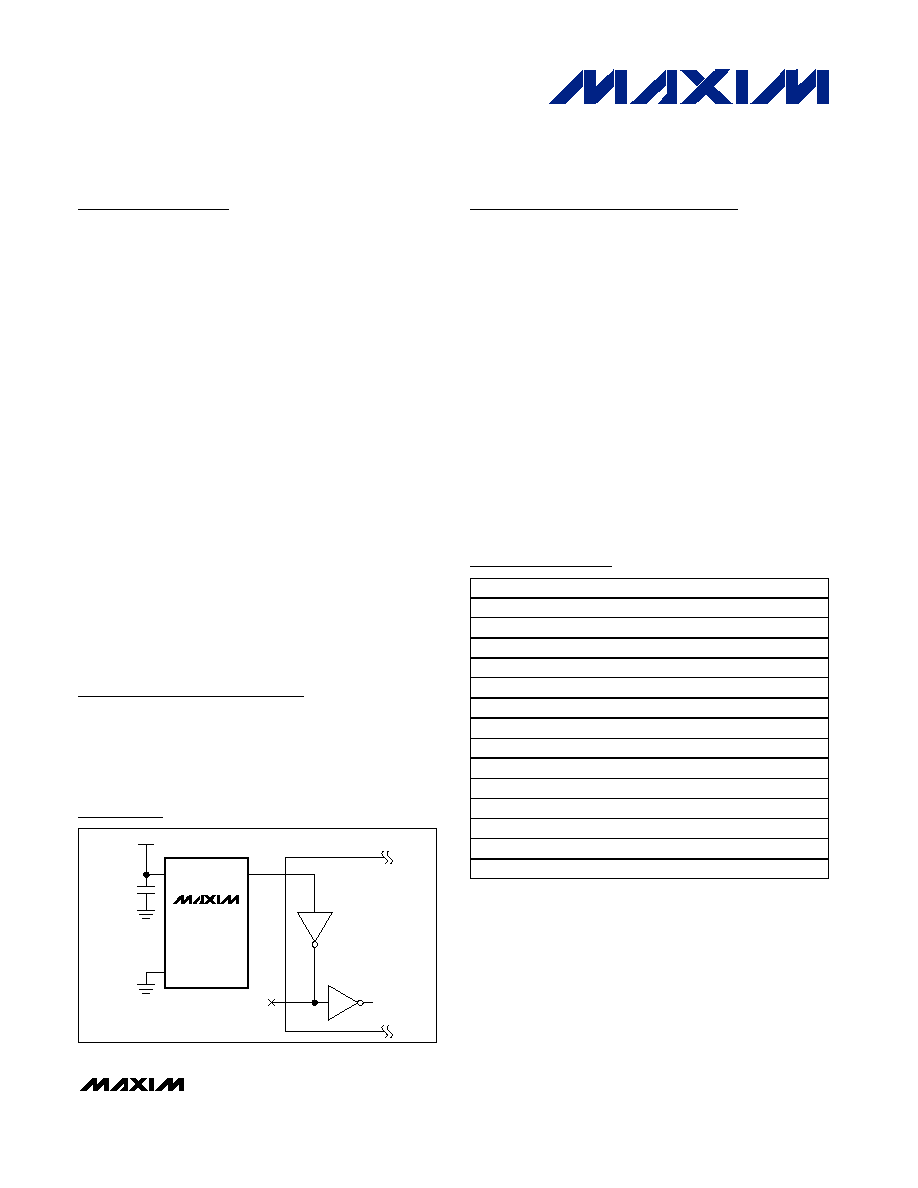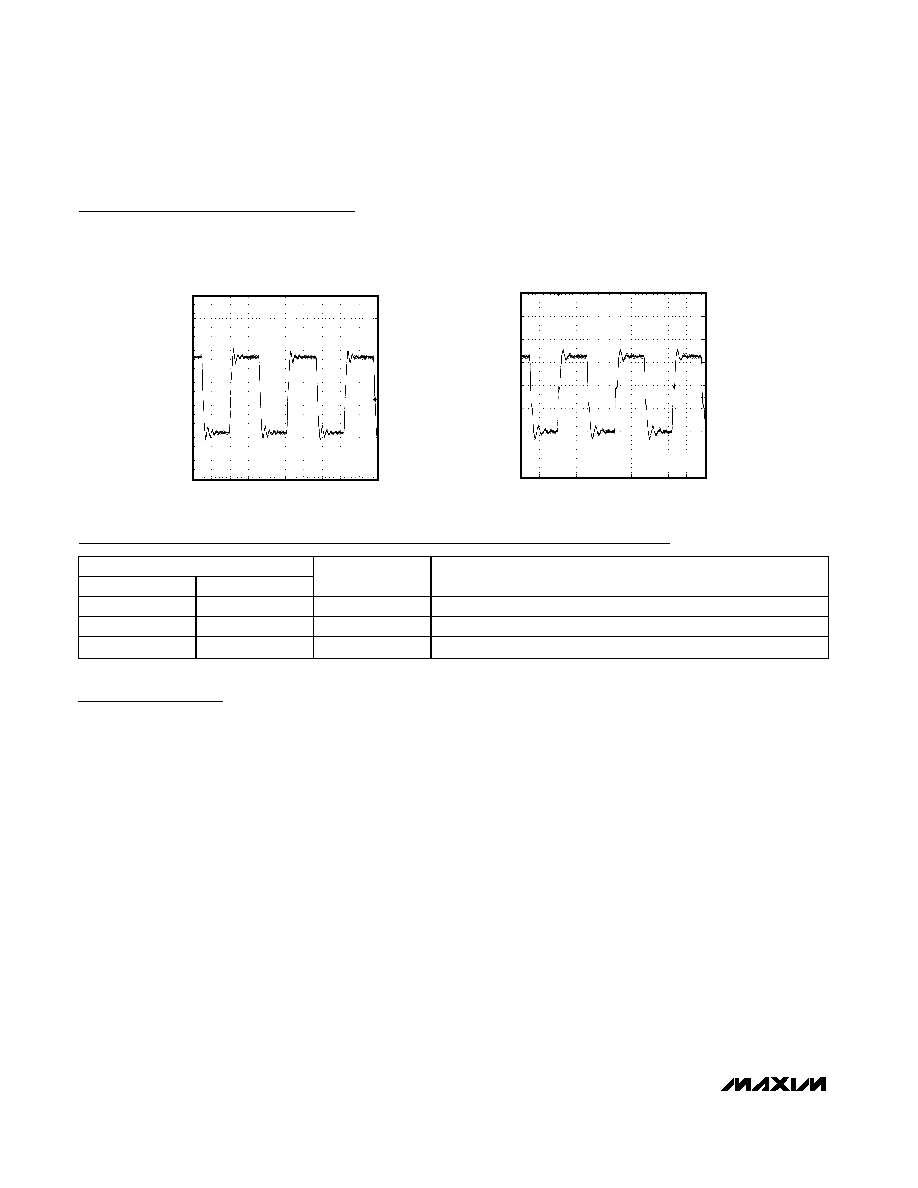Äîêóìåíòàöèÿ è îïèñàíèÿ www.docs.chipfind.ru

General Description
The MAX7375 is a silicon oscillator, intended as a low-
cost improvement replacing ceramic resonators, crys-
tals, and crystal oscillator modules used as the clock
source for microcontrollers and UARTs in 3V, 3.3V, and
5V applications.
The MAX7375 is a fully integrated oscillator, supplied at
specific factory-trimmed frequencies with a Rail-to-
Rail® 50% duty cycle square-wave output. The oscilla-
tor frequency is generated directly without the use of a
phase-locked loop (PLL). No additional components
are used to set or adjust the frequency.
Unlike typical crystal and ceramic resonator oscillator
circuits, the MAX7375 is highly resistant to vibration
and EMI. The high output drive current and absence of
high-impedance nodes also makes the oscillator less
susceptible to dirty or humid operating conditions. With
a wide operating temperature range, the oscillator is a
good choice for demanding home appliance and auto-
motive environments.
Available in 3-pin space-saving SC70 and SOT23 pack-
ages, the MAX7375 is offered in standard and nonstan-
dard factory-set frequencies ranging from 600kHz to
9.99MHz. See the MAX7381 data sheet for frequencies
10MHz. The MAX7375's standard operating temperature
range is -40°C to +125°C. See the Applications
Information section for extended operating temperature
range.
Applications
White Goods
Portable Equipment
Automotive
Microcontroller Systems
Appliances and Controls
Hand-Held Products
Features
2.7V to 5.5V Operation
Factory-Trimmed Oscillator (600kHz to 9.99MHz)
No External Components Required
±10mA Output Drive Current
2% Initial Accuracy
±50ppm/°C Temp Drift
Fast Startup Time: 5µs
40% to 60% Maximum Duty Cycle
5ns Output Rise and Fall Time-Low EMI
Very Low EMI Susceptibility-No High-Impedance
Nodes
Very Low Jitter: 160ps
P-P
at 8MHz
Tiny Surface-Mount Package (SC70, SOT23)
-40°C to +125°C Temperature Range
MAX7375
3-Pin Silicon Oscillator
________________________________________________________________ Maxim Integrated Products
1
Ordering Information
19-3060; Rev 2; 7/04
For pricing, delivery, and ordering information, please contact Maxim/Dallas Direct! at
1-888-629-4642, or visit Maxim's website at www.maxim-ic.com.
PART
TEMP RANGE
PIN-PACKAGE
MAX7375AXR105-T
-40°C to +125°C
3 SC70-3
MAX7375AXR185-T
-40°C to +125°C
3 SC70-3
MAX7375AXR365-T
-40°C to +125°C
3 SC70-3
MAX7375AXR375-T
-40°C to +125°C
3 SC70-3
MAX7375AXR405-T
-40°C to +125°C
3 SC70-3
MAX7375AXR425-T
-40°C to +125°C
3 SC70-3
MAX7375AXR805-T
-40°C to +125°C
3 SC70-3
MAX7375AUR105-T
-40°C to +125°C
3 SOT23-3
MAX7375AUR185-T
-40°C to +125°C
3 SOT23-3
MAX7375AUR365-T
-40°C to +125°C
3 SOT23-3
MAX7375AUR375-T
-40°C to +125°C
3 SOT23-3
MAX7375AUR405-T
-40°C to +125°C
3 SOT23-3
MAX7375AUR425-T
-40°C to +125°C
3 SOT23-3
MAX7375AUR805-T
-40°C to +125°C
3 SOT23-3
MAX7375
OSC1
OSC2
2.7V TO 5.5V
V+
GND
CLOCK
µC
Typical Application Circuit
Pin Configuration and Selector Guide appear at end of data
sheet.
Rail-to-Rail is a registered trademark of Nippon Motorola, Ltd,
The MAX7375 is available in factory-set frequencies from 600kHz
to 9.99MHz. There are seven standard versions (1MHz, 1.84MHz,
3.58MHz, 3.69MHz, 4MHz, 4.19MHz, and 8MHz, as shown in the
Selector Guide) with a required 2.5k order increment.
Nonstandard frequencies are also available with a required 10k
order increment. For nonstandard versions, contact factory for
availability and ordering information. All versions available in
tape-and-reel only.

MAX7375
3-Pin Silicon Oscillator
2
_______________________________________________________________________________________
ABSOLUTE MAXIMUM RATINGS
ELECTRICAL CHARACTERISTICS
(V+ = 2.7V to 5.5V, T
A
= -40°C to +125°C, unless otherwise noted. Typical values are at V+ = 5V, T
A
= +25
°C, unless otherwise noted.)
(Note 1)
Stresses beyond those listed under "Absolute Maximum Ratings" may cause permanent damage to the device. These are stress ratings only, and functional
operation of the device at these or any other conditions beyond those indicated in the operational sections of the specifications is not implied. Exposure to
absolute maximum rating conditions for extended periods may affect device reliability.
Note 1: All parameters are tested at T
A
= +25°C. Specifications over temperature are guaranteed by design and characterization.
Note 2: Typical frequencies are nominal values.
Note 3: Guaranteed by design and characterization. Not production tested.
PARAMETER
SYMBOL
CONDITIONS
MIN
TYP
MAX
UNITS
Operating Supply Voltage
V+
2.7
5.5
V
MAX7375A_R105
0.55
1.1
MAX7375A_R185
0.8
1.25
MAX7375A_R405
1.7
4.2
Operating Supply Current
I+
MAX7375A_R805
3.2
6.4
mA
V+
2.7V, I
SOURCE
= 2.5mA
V+ - 0.4
Output High Voltage
V
OH
V+
4.5V, I
SOURCE
= 9mA
V+ - 0.4
V
V+
2.7, I
SINK
= 10mA
0.4
Output Low Voltage
V
OL
V+
4.5V, I
SINK
= 20mA
0.4
V
V+ = 3.0V,
T
A
= +25°C (Note 2)
MAX7375A_R_
_
_
-2
+2
Initial CLOCK Frequency
Accuracy
f
CLOCK
V+ = 2.7V to 5.5V,
T
A
= +25°C (Note 2)
MAX7375A_R_
_
_
-4
+4
%
CLOCK Frequency Temperature
Sensitivity
(Note 3)
±50
±325
ppm/°C
Duty Cycle
(Note 3)
45
52
57
%
Output Jitter
Observation for 20s using a 500MHz
oscilloscope (MAX7375A_R805)
160
ps
P-P
Output Rise Time
t
R
(Note 3)
5.0
ns
Output Fall Time
t
F
(Note 3)
2.5
ns
V+ to GND ................................................................-0.3V to +6V
CLOCK to GND ............................................-0.3V to (V+ + 0.3V)
Continuous Power Dissipation (T
A
= +70°C)
3-Pin SC70 (derate 2.9mW/°C over +70°C) .................235mW
3-Pin SOT23 (derate 4mW/°C over +70°C ...................320mW
Operating Temperature Range .........................-55°C to +135°C
Junction Temperature ......................................................+150°C
Storage Temperature Range .............................-65°C to +150°C
Lead Temperature (soldering, 10s) .................................+300°C

MAX7375
3-Pin Silicon Oscillator
_______________________________________________________________________________________
3
DUTY CYCLE vs. TEMPERATURE
MAX7375 toc01
TEMPERATURE (
°C)
DUTY CYCLE (%)
110
95
65 80
-10 5
20 35 50
-25
46
47
48
49
50
51
52
53
54
55
45
-40
125
DUTY CYCLE vs. SUPPLY VOLTAGE
MAX7375 toc02
SUPPLY VOLTAGE (V)
DUTY CYCLE (%)
4.8
4.1
3.4
47
49
51
53
55
45
2.7
5.5
SUPPLY CURRENT vs. TEMPERATURE
MAX7375 toc03
TEMPERATURE (
°C)
SUPPLY CURRENT (mA)
110
95
65 80
-10 5
20 35 50
-25
0.5
1.0
1.5
2.0
2.5
3.0
3.5
4.0
0
-40
125
V+ = 3.3V
V+ = 5V
V+ = 2.7V
SUPPLY CURRENT vs. SUPPLY VOLTAGE
MAX7375 toc04
SUPPLY VOLTAGE (V)
SUPPLY CURRENT (mA)
4.8
4.1
3.4
2.0
2.5
3.0
3.5
4.0
1.0
1.5
2.7
5.5
FREQUENCY vs. SUPPLY VOLTAGE
MAX7375 toc05
SUPPLY VOLTAGE (V)
NORMALIZED FREQUENCY
4.8
4.1
3.4
0.994
0.996
0.998
1.000
1.002
0.990
0.992
2.7
5.5
0.980
0.990
0.985
1.000
0.995
1.015
1.010
1.005
1.020
-40
10
-15
35
60
85
110
135
FREQUENCY vs. TEMPERATURE
MAX7375 toc06
TEMPERATURE (
°C)
NORMALIZED FREQUENCY
SETTLING TIME FROM START
MAX7375 toc08
1
µs/div
V+
2V/div
CLOCK
2V/div
V+ = 3.3V
CLOCK OUTPUT WAVEFORM
WITH C
L
= 10pF
MAX7375 toc09
40ns/div
CLOCK
1V/div
V+ = 3.3V
Typical Operating Characteristics
(V+ = 5V, T
A
= +25
°C, C
L
= 10pF, 8MHz output, unless otherwise noted.)
SUPPLY CURRENT vs. FREQUENCY
MAX7375 toc07
FREQUENCY (MHz)
SUPPLY CURRENT (mA)
6.5
4.5
2.5
0.5
1.0
1.5
2.0
2.5
3.0
3.5
4.0
0
0.5
8.5
V+ = 5.5V
V+ = 5V
V+ = 3.3V
V+ = 2.7V

MAX7375
Detailed Description
The MAX7375 is a replacement for ceramic resonators,
crystals, and crystal oscillator modules as the clock
source for microcontrollers and UARTs in 3V, 3.3V, and
5V applications. The MAX7375 is an integrated oscilla-
tor, supplied at specific frequencies just like crystals
and resonators. A variety of popular standard frequen-
cies are available. No external components are
required for setting or adjusting the frequency.
Supply Voltages
The MAX7375 has been designed for use in systems
with nominal supply voltages of 3V, 3.3V, or 5V and is
specified for operation with supply voltages in the 2.7V
to 5.5V range. Operation outside this range is not guar-
anteed. See the Absolute Maximum Ratings table for
limit values of power-supply and pin voltages.
Oscillator
The clock output is a push-pull configuration and is
capable of driving a ground-connected 1k
load or a
positive supply connected 500
load to within 300mV
of either supply rail. The clock output remains stable
over the full operating voltage range and does not gen-
erate short output cycles during either power on or
power off. A typical startup characteristic is shown in
the Typical Operating Characteristics section.
Output Jitter
The MAX7375's jitter performance is given in the
Electrical Characteristics table as a peak-to-peak value
obtained by observing the output of the MAX7375 for
20s with a 500MHz oscilloscope. Jitter measurements
are approximately proportional to the period of the out-
put frequency of the device. Thus, a 4MHz part has
approximately twice the jitter value of an 8MHz part.
The jitter performance of all clock sources degrades in
the presence of mechanical and electrical interference.
The MAX7375 is relatively immune to vibration, shock,
and EMI influences and thus provides a considerably
more robust clock source than crystal- or ceramic-res-
onator-based oscillator circuits.
3-Pin Silicon Oscillator
4
_______________________________________________________________________________________
PIN
SC70
SOT23
NAME
FUNCTION
1
2
V+
Positive Supply Voltage
2
1
CLOCK
Clock output. Output is push-pull.
3
3
GND
Ground
Pin Description
Typical Operating Characteristics (continued)
(V+ = 5V, T
A
= +25
°C, C
L
= 10pF, 8MHz output, unless otherwise noted.)
CLOCK OUTPUT WAVEFORM
WITH C
L
= 50pF
MAX7375 toc10
40ns/div
CLOCK
1V/div
V+ = 3.3V
CLOCK OUTPUT WAVEFORM
WITH C
L
= 100pF
MAX7375 toc11
40ns/div
CLOCK
1V/div
V+ = 3.3V

Applications Information
Interfacing to a Microcontroller Clock
Input
The MAX7375 clock output is a push-pull, CMOS, logic
output, which directly drives any microprocessor (µP)
or microcontroller (µC) clock input. There are no imped-
ance-matching issues when using the MAX7375.
Operate the MAX7375 and microcontroller (or other
clock input device) from the same supply voltage level.
Refer to the microcontroller data sheet for clock input
compatibility with external clock signals.
The MAX7375 requires no biasing components or load
capacitance. When using the MAX7375 to retrofit a
crystal oscillator, remove all biasing components from
the oscillator input.
Startup Performance
The MAX7375 oscillator output stabilizes within a few
cycles of operation after V+ rises to a sufficient voltage
to start the oscillator, typically 1.65V at +25
°C. Use a
reset or similar voltage-detection circuit to disable
devices connected to the MAX7375 until 5µs after the
voltage on V+ has risen above 2.7V.
Extended Temperature Operation
The MAX7375 was tested to +135°C during product
characterization and shown to function normally at this
temperature (see Typical Operating Characteristics).
However production test and qualification is only per-
formed from -40°C to +125°C at this time. Contact the
factory if operation outside this range is required.
Power-Supply Considerations
The MAX7375 operates with power-supply voltages in
the 2.7V to 5.5V range. Good power-supply decoupling
is needed to maintain the power-supply rejection per-
formance of the MAX7375. Use a 0.1µF surface-mount
ceramic capacitor connected between V+ and GND
and mounted as close to the device as possible. If pos-
sible, mount the MAX7375 close to the microcontroller's
decoupling capacitor so that additional decoupling is
not required.
A larger value of bypass capacitor is recommended if
the MAX7375 is to operate with a large capacitive load.
Use a bypass capacitor value of at least 1000 times
that of the output load capacitance.
MAX7375
3-Pin Silicon Oscillator
_______________________________________________________________________________________
5
PART
FREQUENCY (MHz)
TOP MARK
MAX7375AXR105
1.00
AOV
MAX7375AXR185
1.84
AOU
MAX7375AXR365
3.58
AOT
MAX7375AXR375
3.69
AOS
MAX7375AXR405
4.00
AOR
MAX7375AXR425
4.19
AOQ
MAX7375AXR805
8.00
AOP
MAX7375AUR105
1.00
FZPZ
MAX7375AUR185
1.84
FZPT
MAX7375AUR365
3.58
FZPU
MAX7375AUR375
3.69
FZPV
MAX7375AUR405
4.00
FZPY
MAX7375AUR425
4.19
FZPW
MAX7375AUR805
8.00
FZPX
Selector Guide
CLOCK
1
3
GND
V+
MAX7375AXR
SC70
TOP VIEW
2
V+
1
3
GND
CLOCK
MAX7375AUR
SOT23
2
Pin Configuration
Chip Information
TRANSISTOR COUNT: 432
PROCESS: BiCMOS




